The earliest known octopus fossil dates from the Carboniferous period approximately 296 million years ago, and today there are around 300 known species. Octopuses inhabit all of the world’s oceans—from shallow tide pools to the abyssal plains.
Here are eight cool species:
1. Enteroctopus dofleini
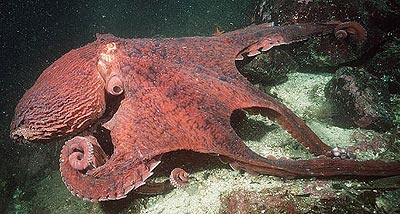
Common name: North Pacific Giant Octopus
Inhabiting the chilly waters of the northern Pacific is the mighty Enteroctopus dofleini. With a scientifically verified record weight of 71 kg (156.5 lb), it is generally considered the world’s largest octopus. (Although the rare Seven-Arm Octopus may hold a legitimate claim on that title.) A more typical size for an adult Giant Octopus is around 15 kg (33 lb), with an arm span of up to 4.3 m (14 ft)—still significantly larger than just about any other kind of octopus. Their diet consists of crustaceans, bivalves, and fish, and they have even been observed preying on sharks! With an average life span of 4-5 years, the North Pacific Giant Octopus is actually one of the longest lived octopus species.
2. Thaumoctopus mimicus
Common name: Mimic Octopus
Unknown to science until its discovery in Indonesian waters in 1998, T. mimicus has been observed mimicking both the movements and physical aspects of as many as 15 different species. I’d go into more detail, but you really should just watch the video. The typical coloration of a Mimic Octopus is white and reddish-brown stripes, and the they can grow up to 2 feet in length.
3. Hapalochlaena sp.
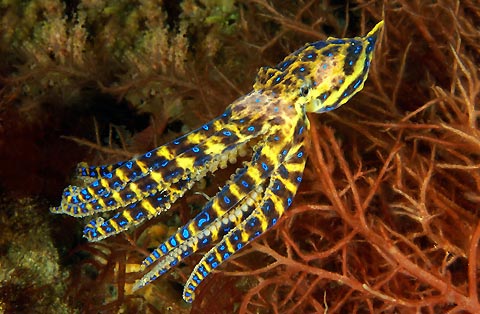
Common name: Blue-ringed Octopus
The genus Hapalochlaena, which consists of at least three species, is found in tide pools across the western Pacific ocean. The common name of this octopus obviously comes from its striking coloration—blue rings (and stripes in one species) on bright yellow. It’s a good thing that these little octopuses are marked so vividly because they are one of the most venomous creatures in the world. Although it has been recently found that all octopuses (as well as cuttlefish, and some squid) are venomous, only the Blue-ringed Octopus is deadly to humans. Despite their tiny size (the largest species only grow to about 5 inches), a single individual contains enough venom to kill as many as 26 adult humans. For those unlucky enough to be bitten, death from respiratory paralysis and cardiac arrest can come in a matter of minutes, and there is no known antivenin.
4. Argonauta sp.
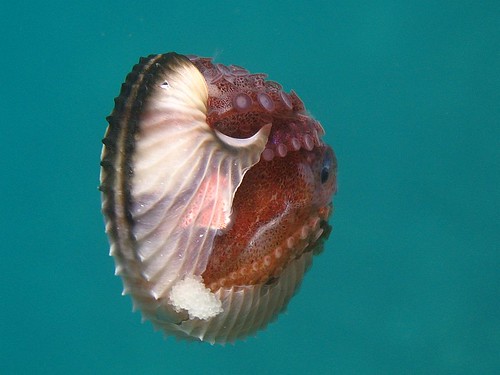
Common name: Argonaut, Paper Nautilus
Argonauts live in the open ocean in tropical and sub-tropical waters world-wide. Unlike most other kinds of octopus, Argonauts live near the surface, and in Classical times it was believed that they used their specialized shell-secreting arms as sails. It is their shells, which are actually egg cases produced by the female Argonaut, that give them their other common name: Paper Nautilus. Despite the uncanny visual similarity to the shells of the Chambered Nautilus and those of extinct ammonites, the Argonaut egg case is very different biologically (and mineralogically) from a true shell. Interestingly, the Chambered Nautilus was so named because of its apparent similarity to the Argonaut, even though we now consider the former to be the “true” Nautilus. There are at least six extant species of Argonaut, with several more known from the fossil record.
5. Grimpoteuthis sp.
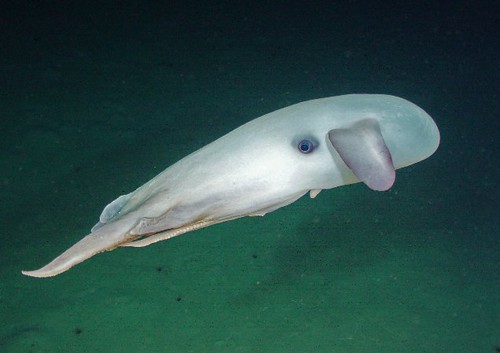
Common name: Dumbo Octopus
Belonging to the Octopus suborder Cirrina, the genus Grimpoteuthis consists of over a dozen rare and poorly-known species, all of which are found in the extreme depths of the ocean. They are small, not getting much bigger than 20 cm (8 in), and their common name comes from the ear-like pair of fins (present in all cirrate octopuses, but generally larger in the Dumbos) which are used to assist locomotion the same way a squid uses its fins. Like other cirrate octopuses, the arms of the Dumbo Octopus are completely webbed, and they also retain an internal shell, something the more common incirrate octopuses (i.e. every other kind of octopus) have lost entirely. Dumbo Octopuses spend their time either sitting on the sea floor, or swimming just above it searching for food.
6. Amphioctopus marginatus

Common name: Coconut Octopus, Veined Octopus
Inhabiting sandy the bottoms of tropical lagoons of the western Pacific, A. marginatus often hides from potential predators by building itself a protective fortress out of debris from its environment. It seems to be particularly partial to coconut shells, and that’s the reason why one of its common names is the Coconut Octopus. (The other name is a reference to its dark vein-like color pattern.) In recent years, the Coconut Octopus has been observed walking bipedally. In one instance, one was seen to literally run across the sea floor on two arm while the rest of its body mimicked the shape and texture of a coconut! (The same report also includes a video of an individual of another species—Abdopus aculeatus—which was filmed walking backwards on two arms while adopting a posture reminiscent of floating algae.)
7. Tremoctopus sp.
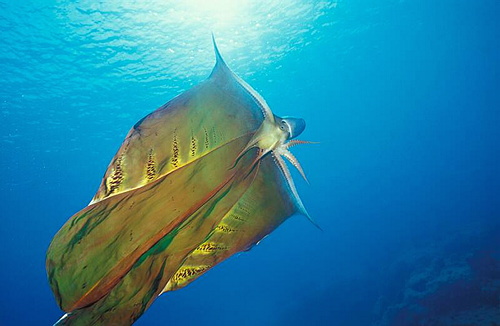
Common name: Blanket Octopus
Behold the beautiful and otherworldly Blanket Octopus. Like the Argonauts (to which they are closely related), they live near the ocean’s surface, and can be found in both tropical and subtropical waters. There are four known species (the one depicted here is apparently T. gracilis, aka the Palmate Octopus), all of which share the same astounding anatomical and behavioral traits unique to this genus. Let’s begin with the name. As should be obvious from the image above, the female Blanket Octopus has two arms (the dorsal and dorsolateral, if you want to get technical about it) which are significantly longer than the rest and are connected to two other arms by a massive sheet-like membrane (the webbing is absent from the other four arms). It seems this “blanket” is unfurled when the animal feels threatened, presumably to make it appear bigger to any potential predator. Young individuals practice an altogether different defensive strategy. Apparently immune to the venom, they have been observed to carry pieces of the stinging tentacles of the Portuguese Man o’ War. The Blanket Octopus also exhibits one of the most extreme examples of sexual dimorphism of any animal: males, at 2.4 cm (or smaller), are minute, while the females can exceed 2 m in length.
8. Vulcanoctopus hydrothermalis

Common name: N/A
Vulcanoctopus is the only known cephalopod adapted to life in hostile hyrothermal vent environments. This little, and little-known, octopus lacks chromatophores (the specialized cells that give most octopuses the ability to change their color almost instantaneously) and pigment of any kind. Its eyes have greatly reduced functionality, perhaps even a complete loss of function, as they show no reaction to light when encountered in the wild. They are known to eat amphipods and have been observed hunting vent crabs.
Source
